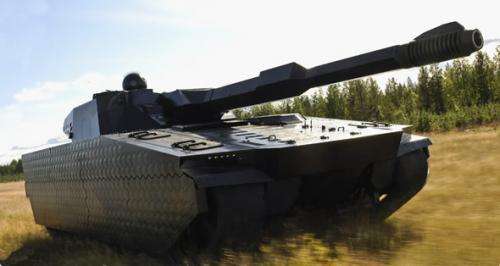September 7, 2011 report
New camouflage technology from BAE hides war machines

(PhysOrg.com) -- BAE Systems says it has a camouflage system that can render battle machines like tanks invisible or even seen as other objects in the immediate environment to protect against attack. The 'cloak' applied to a tank, which is BAE's illustrated object to showcase its Adaptiv technology, can enable the tank to blend into the environment undetected or to look like another object entirely, avoiding night vision surveillance equipment and infrared targeting by aircraft. In so doing, the Adaptiv technology can mask the vehicle's infrared signature.
The Adaptiv cloak consists of a sheet of hexagonal hand-sized patches, or as BAE calls them, pixels. Their thermo electric material can switch temperatures quickly. On-board thermal cameras are what drive the panels, picking up whatever scenery is around and then showing that image on the vehicle. Around 1,000 of these panels can cover a small tank.
BAE field-tested its technology on a Swedish CV90 tank made to blend into the scenery without detection. Alternatively, the pixels can protect gear by manipulating their appearance. Tanks can be made to look like cars, large rocks, trucks,or cows, for example.
The Swedish Defence Materiel Administration (FMV), helped fund BAE's project; use of the infra-red spectrum in warfare has been an important focus for them.
BAE estimates that the technology could be ready for production in two years. Later this month BAE will demonstrate the technology on a CV90 tank at the UK Defense and Security Equipment International exhibition from September 13 to 16. According to reports, research about the Adaptiv approach has been submitted to Britain’s Ministry of Defence.
Since the days when infantry men marched in confidence wearing helmets with hanging leaves, technology has come a long way and has a way to go in the use of camouflage in the face of modern weapons. BAE sees its Adaptiv technology as a breakthrough, however. Past attempts have entailed excessive power requirements and that's where Adaptiv stands out. Adaptiv project manager Pader Sjolund in a statement said Adaptiv panels in contrast consume relatively little power. "Our panels can be made so strong that they provide useful armor protection and consume relatively low levels of electricity," he said.
No doubt developments and ideas to address camouflage for warfare will continue in and outside BAE Systems. "Invisibility cloaks" is a topic of research that has been explored for some time. In 2006, Sir John Pendry at Imperial College London, led a group that focused on a "transformation optics" technique that involves the design of materials that steer light around objects, making them disappear from view.
More information: Press release
© 2011 PhysOrg.com

















